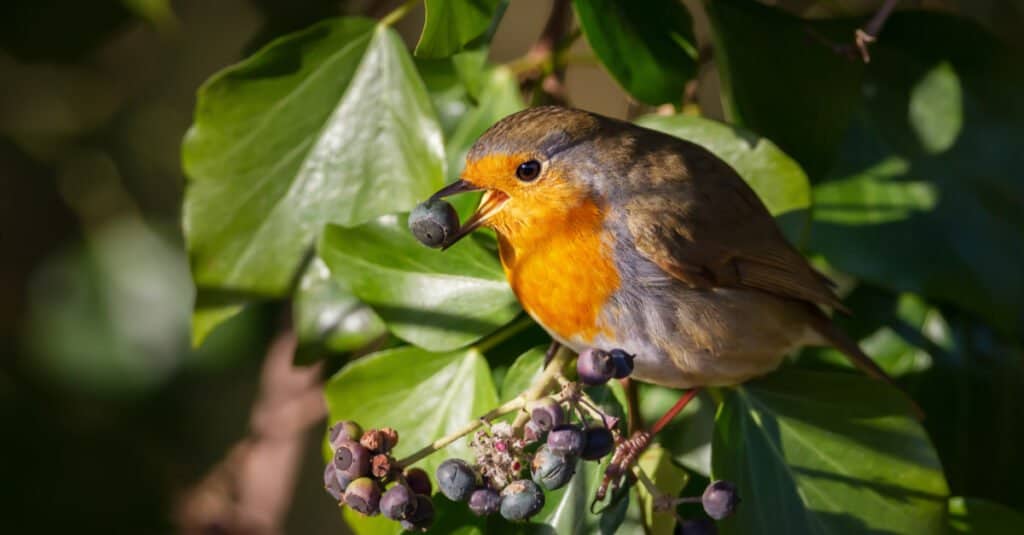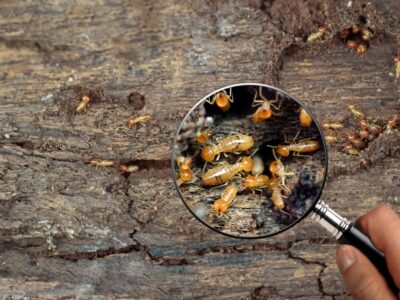European Robin
Erithacus rubecula
Male robins are so aggressive and territorial that they will attack their own reflections.
Advertisement
European Robin Scientific Classification
- Kingdom
- Animalia
- Phylum
- Chordata
- Class
- Aves
- Order
- Passeriformes
- Family
- Muscicapidae
- Genus
- Erithacus
- Scientific Name
- Erithacus rubecula
Read our Complete Guide to Classification of Animals.
European Robin Conservation Status
European Robin Facts
- Prey
- Insects, spiders and worms
- Fun Fact
- Male robins are so aggressive and territorial that they will attack their own reflections.
- Biggest Threat
- Hunting on the continent
- Most Distinctive Feature
- Its red/orange breast
- Other Name(s)
- Robin, redbreast, English robin, ruddock, robinet, chat
- Wingspan
- 7.9 to 8.7 inches
- Incubation Period
- 13 days
- Litter Size
- Five to six chicks
- Habitat
- Gardens, farms, woods, heathland
- Predators
- Humans, cats, dogs, birds of prey, snakes, rodents
- Diet
- Omnivore
- Type
- Bird
- Common Name
- European Robin
- Location
- Europe, western Russia, northern Africa, Middle East
- Nesting Location
- Anywhere that provides shelter, including nest boxes, flower pots, crevices and unused machinery
- Age of Molting
- 14 days
- Migratory
- 1
View all of the European Robin images!
“A European Robin is referred to as a Pretty Little Redbreasted Thug”
This chubby little creature is a welcome sight to farmers and gardeners alike as it loves to eat insects, including insect pests. It also delights with its burbling song, which begins at dawn and may even continue into the night. On the other hand, the European robin is rather thuggish to members of its own species and even other birds. It’s no wonder that several soccer and rugby teams are named after it! Read on for more information about this feisty little bird.
4 Amazing European Robin Facts!
- Robins lay eggs from March to the end of July. The female can incubate the eggs of one family while the male feeds the chicks of the other.
- Though the average lifespan of a European robin is a little over a year, at least one lived for 19 years.
- Its song is heard at night in locations with artificial light.
- Some scientists believe they use quantum entanglement to navigate.
- Robins became symbols of Christmas in Britain during the Victorian era.
Where To Find the European Robin
The European robin is found in Europe, North Africa, Russia, and parts of the Middle East. It lives in habitats such as gardens, backyards, hedgerows, parks, woods, and heathlands.
European Robin Nests
Robins are not fussy about where they build their nests. They can be constructed in boltholes or on top of barbecue grills, in old hats and old boots. Robins also appreciate nest boxes, especially those with open fronts that are nicely hidden among shrubs or vines and no more than 6.56 feet off the ground. The female makes the nest out of moss, grass, and leaves and lines it with hair and feathers. It is usually cup-shaped.
European Robin Scientific Name
The scientific name of the robin is Erithacus rubecula. The genus name, Erithacus is Greek for a type of bird that some historians believe was the European robin. The species name, rubecula is derived from ruber, the Latin word for “red.” There are nine subspecies:
- E.r. melophilus
- E. r. witherbyi
- E. r. tataricus
- E. r. valens
- E. r. caucasicus
- E. r. hyrcanus
- E. r. microrhynchos
- E. r. marionae
- E. r. superbus
European Robin Appearance
The European robin does not have a red breast. The vivid color on part of its head and breast is orange, but when the bird was named back in the 15th century there was no word for “orange.” Other than this, Erithacus rubecula is a little bird between 4.9 and 5.5 inches long with a 7.9 to 8.7-inch wingspan. It has a short tail, a short beak, and bright, dark, beady eyes. The feathers on the side of its chest and neck are bluish-gray, and its back is a shade of brown. It has a white belly, and its feet and spindly legs are brown. Chicks are speckled brown and white, and their orange breast grows as they mature. Both female and male robins have the same coloration.

©Giedriius/Shutterstock.com
European Robin vs. American Robin
Despite belonging to the Aves class, the European robin and the American robin are not closely related to each other. The American robin was given its name because its breast reminded settlers of the bird they’d left behind in England. But there are several differences as well as similarities between these two songbirds.
The American robin, Turdus migratorius is a much larger bird than the European. It grows between 9 to 11 inches long and has a 12 to 16-inch wingspan, which makes it one of the largest of the thrushes. The European robin, on the other hand, is considered a type of flycatcher. The American robin’s breast is entirely covered by some shade of red, its back is brown, and the color of its head ranges from brown to black. Its bill is yellow and has a dark tip, it has a white throat streaked with black, and the abdomen and the coverts beneath its tail are also white. Unlike the European robin, it is native to North America, though some migrants have been found in Europe. People tried to introduce the European robin to America, but the attempt failed.
As its name implies, Turdus migratorius is more of a migratory bird than the European robin, though many American robins found in the United States remain in their range all year.
The eggs of the European robin are reddish-brown and speckled, while the eggs of the American robin are famously blue. Both are omnivores that eat invertebrates and fruits, including berries. The American robin has seven subspecies, while the European robin has nine. T. migratorius also live a bit longer than E. rubecula. American robins have an average lifespan of two years, though they can live to be 12 years old in captivity.
Both robins are plentiful, and their conservation status is least concern.
European Robin Behavior
The European robin is largely a solitary bird, and it tends to hunt during the day. It will hunt at night if it is exposed to artificial lights or moonlit nights. In the United Kingdom and Ireland, it is fairly tame, as there are taboos against hunting it. It will hang around people or animals that are digging in the soil in the hope that the digging will turn up the worms and other burrowing invertebrates that make up its diet. It is prized for beginning its beautiful song at the crack of dawn. These birds sing all year long and only go quiet during their midsummer molt.
Though it has a sweet look about it, European robins, especially males are territorial and will violently defend their territory. They’ll not only attack other robins but other small birds who come too near. Males have been known to attack their own reflection in a mirror or windowpane. Fights can become so intense that there are places where as much as 10 percent of adult European robin deaths are due to intraspecies combat.
European Robin Migration Pattern and Timing
Though most European robins stay in their home range year-round, the ones who live in Scandinavia and Russia migrate to the continent in winter.
European Robin Diet
The redbreast is largely an insectivore during the spring and summer, but in winter it eats berries, fruit, and seeds. Cold winters are hard on these birds, and it is a good idea to put food out, including suet, mixed seeds, and mealworms during this time.
European Robin Predators and Threats
The robin’s pugilistic attitude can only help it so far when it comes to predators such as domestic cats and dogs, foxes, rodents, and birds of prey. Snakes also take eggs and chicks. Humans who do not live in the British Isles kill them in great numbers as they migrate even though this has not caused a decline in the population. The bird is also subject to parasites such as the moorhen flea and a spiny-headed worm called Apororhynchus silesiacus.
European Robin Reproduction, Babies, and Lifespan
The redbreast starts to breed in March, though couples can start courting as early as January. During this time the male not only defends a territory, puffing out his red breast and singing to challenge other males but feeds the female. She is the one who builds the nest in a place, any place, that provides enough shelter. She can lay as many as three clutches during the breeding season, and she usually lays five to six eggs. She incubates them, and they hatch after 13 days. Both parents feed the chicks.
The chicks finally fledge when they’re about two weeks old, but their father takes care of them while their mother incubates a new clutch of eggs. The lifespan of this bird is only about 13 months, but it has been known to live as long as 19 years.
European Robin Population
The population of the European robin is estimated to be between 117,000,000 and 181,000,000 adult birds. Its conservation status is least concern.
View all 117 animals that start with EEuropean Robin FAQs (Frequently Asked Questions)
Does the European Robin Migrate?
European robins who live in the colder part of their range migrate south in the winter.
How many eggs does the European Robin lay?
It lays between five and six eggs.
How fast does the European Robin fly?
It can fly as fast as 35 miles per hour.
What is the European Robin’s wingspan?
It has a wingspan of 7.9 to 8.7 inches.
When does the European Robin leave the nest?
European robin chicks leave the next when they’re two weeks old.
Are European robins in the US?
There are no large populations of European robins in the United States. They were introduced in the 19th century but failed to become established.
Is the European robin related to the American robin?
The two birds are actually not related! The American robin belongs to the Turdus genus and the European robin belongs to the Erithacus genus.
Are European robins aggressive?
The redbreast is a surprisingly aggressive little bird. Males sometimes fight to the death and even a female will vigorously defend her territory.
What are the differences between European and American robins?
The key differences between European and American robins include classification, appearance, diet, habitat, reproduction, lifespan, and vocalization.
Thank you for reading! Have some feedback for us? Contact the AZ Animals editorial team.
Sources
- Data Zone, Available here: http://datazone.birdlife.org/species/factsheet/european-robin-erithacus-rubecula/text
- Wikipedia, Available here: https://en.wikipedia.org/wiki/European_robin
- BBC Wildlife, Available here: https://www.discoverwildlife.com/animal-facts/birds/facts-about-robins/
- Natural History Museum, Available here: https://www.nhm.ac.uk/discover/robin-erithacus-rubecula.html
- The Spruce, Available here: https://www.thespruce.com/european-robin-profile-387247
- Wikipedia, Available here: https://en.wikipedia.org/wiki/American_robin


















